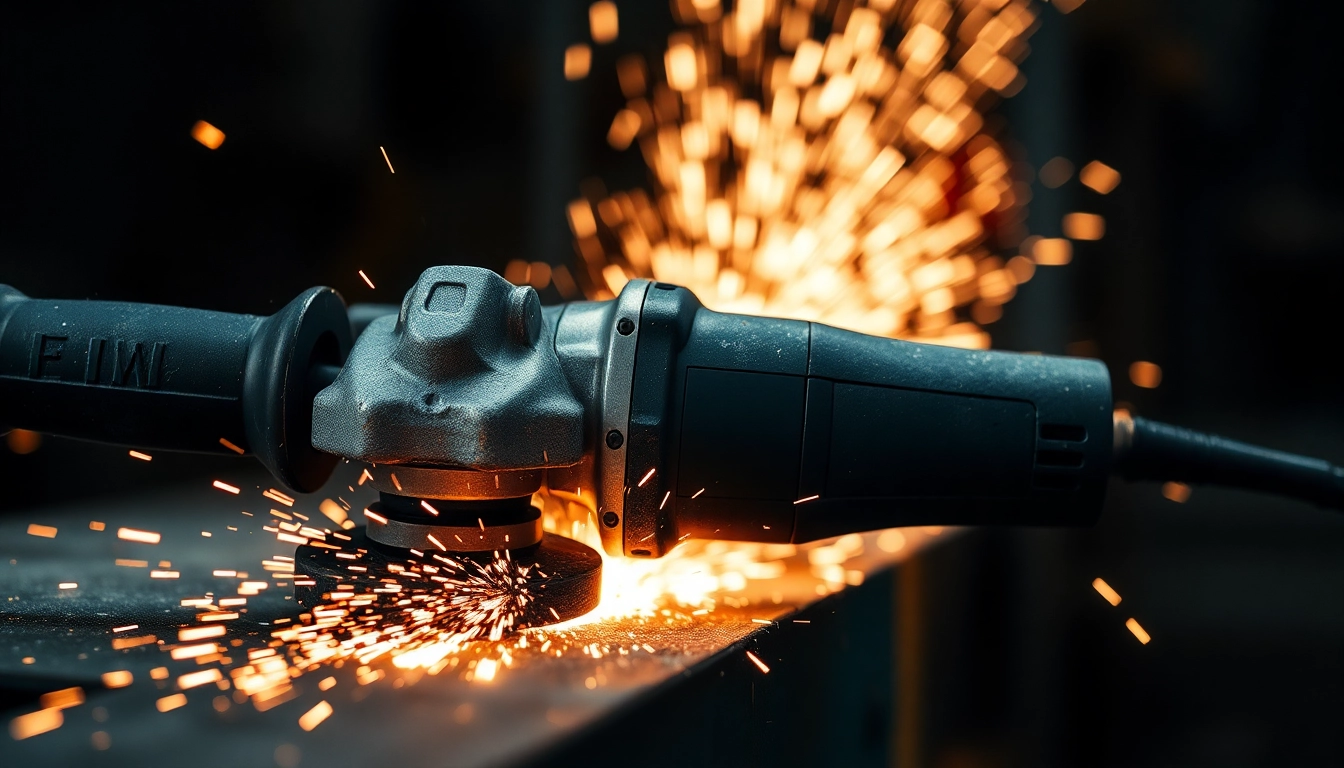Understanding Angle Grinders and Their Applications
Angle grinders are versatile power tools that are essential in a wide range of metalworking and DIY tasks. Renowned for their efficiency in cutting, grinding, and polishing, these tools play a crucial role in construction, metal fabrication, and repair work. Whether you’re a professional tradesman or a DIY enthusiast, understanding angle grinders can help you choose the right tool for your project and use it safely and effectively.
What Are Angle Grinders?
Angle grinders, also known as side grinders or disc grinders, are handheld power tools that utilize a rotating disc or wheel to grind, cut, and polish various materials. They are typically powered by electricity (corded), batteries (cordless), or compressed air. The tool’s head can be angled, allowing users to grind or cut at various positions, which is where it gets the name “angle grinder.” The ability to attach different types of discs enables the angle grinder to perform a wide array of tasks, making it a highly versatile asset on any job site.
Common Uses of Angle Grinders
Angle grinders are highly versatile and can be employed in various applications. Here are some common uses:
- Cutting: Angle grinders are ideal for slicing through metals, tiles, and concrete. Different types of cut-off wheels can be employed based on the material being cut.
- Grinding: They excel in smoothing and shaping surfaces, removing rust, and preparing metal for welding. Grinding wheels are specifically designed for these applications.
- Sanding: With the appropriate sanding discs, angle grinders can efficiently smooth wood, plastic, and metal surfaces.
- Polishing: Used with polishing pads, angle grinders help achieve a shiny, smooth finish on metals and other surfaces.
- Removing excess material: They can effectively remove paint, mortar, and other surface materials.
Components of an Angle Grinder
Understanding the essential components of an angle grinder aids in effective usage and maintenance. Key components include:
- Motor: The motor powers the grinder and determines its performance. Motors vary in size and wattage, affecting the tool’s cutting and grinding efficiency.
- Disc/Wheel: The disc is the business end of the grinder. Different types of discs (cut-off, grinding, sanding, or polishing) can be attached depending on the task.
- Guard: This is a safety feature that protects users from sparks and debris. It’s crucial to ensure that the guard is properly fitted.
- Handle: Most angle grinders come with an auxiliary handle for better control during use.
- Switch: A safety mechanism that allows the user to turn the tool on and off. Some grinders feature a lock-on switch for extended use.
Choosing the Right Angle Grinder
With a vast array of models available, selecting the right angle grinder can be daunting. Factors to consider include power source, size, and features that suit your specific needs.
Factors to Consider
When determining the appropriate angle grinder for your tasks, consider the following factors:
- Power: Grinders come in various power ratings, typically ranging from 500 to 3,000 watts. Higher wattage usually translates to better performance, especially for heavy-duty tasks. However, for lighter work, a lower wattage model may be sufficient.
- Disc Size: Common disc sizes include 4.5 inches, 7 inches, and 9 inches. The size you choose affects the type of tasks you can perform. Smaller discs are more maneuverable, while larger ones offer deeper cuts but can be less manageable.
- Speed: The speed at which an angle grinder operates is crucial; high RPM (revolutions per minute) offers more cutting power. Look for grinders with adjustable speed settings for versatility.
- Comfort and Control: Ergonomics play a vital role in preventing fatigue. Look for grinders with adjustable handles, anti-vibration features, and lightweight designs.
- Durability: A sturdy construction is essential for longevity, especially if you’ll use the grinder frequently. Look into materials like magnesium housing, which offers both strength and lightweight characteristics.
Corded vs Cordless Angle Grinders
One of the significant decisions when choosing an angle grinder is whether to go for a corded or cordless model. Here are some comparative insights:
- Corded Angle Grinders: Generally provide more consistent power and higher performance for extended tasks. They’re usually lighter, but the reliance on an outlet can limit mobility.
- Cordless Angle Grinders: Offer unparalleled portability, making them ideal for outdoor or remote locations. Advances in battery technology have improved their performance, although they may not match the power of corded options and generally have limited runtime depending on battery capacity.
Best Brands in the Market
When it comes to angle grinders, several brands are renowned for their quality and performance. Some of the top names in the industry include:
- Dewalt: Known for robust tools that excel in professional settings, Dewalt angle grinders are favored for their durability and performance.
- Makita: This brand offers a wide range of corded and cordless options, known for their user-friendly designs and reliability.
- Bosch: Bosch angle grinders are recognized for their innovative features and ergonomic designs, catering to both professionals and enthusiasts.
- Metabo: Focused on engineering and tools built for longevity, Metabo is often the preferred choice for heavy-duty tasks.
- Milwaukee: Renowned for their high-quality cordless tools, Milwaukee is a favorite amongst professionals for both power and user control.
Safety Practices When Using Angle Grinders
Angle grinders are powerful tools that can pose serious safety risks if not used correctly. Adhering to safety practices is paramount to protect yourself and others while working.
Essential Safety Gear
Before operating an angle grinder, ensure you have the appropriate safety gear. Essential items include:
- Eye Protection: Safety goggles or a face shield to protect against flying debris and sparks.
- Hearing Protection: Earplugs or earmuffs to guard against the potentially damaging noise levels.
- Gloves: Heavy-duty gloves for grip, but avoid loose-fitting types which can catch on the grinder.
- Respirator: If working with materials that create fine dust, wear a respirator to prevent inhalation.
- Proper Clothing: Wear close-fitting clothing and ensure long hair is tied back to prevent entanglement with the grinder.
Common Hazards and How to Avoid Them
Understanding potential hazards while using an angle grinder is vital. Common risks include:
- Sparks and Debris: Always ensure your work area is clear of flammable materials. Use shields or curtains to protect nearby individuals.
- Kickback: This can occur if the wheel gets stuck during operation. Using the appropriate wheel for the task can help mitigate this risk.
- Noise and Vibration: Prolonged exposure can cause hearing loss or hand-arm vibration syndrome. Ensure to take breaks and use anti-vibration tools when necessary.
- Electrical Hazards: Ensure the grinder is well-maintained and check cords for damages. Avoid using power tools in wet conditions.
Proper Operation Techniques
For optimal safety and performance, follow these proper operating techniques:
- Always read the manufacturer’s manual before use, familiarizing yourself with the specific tool.
- Ensure the correct wheel is attached for the task at hand and inspect it before each use to avoid breakage.
- Hold the tool with both hands for better control and stability, especially on uneven surfaces.
- Use the side handle when applicable to maintain stability and prevent the grinder from slipping.
- Maintain a safe distance from others while working and always be aware of your surroundings.
- Disconnect the power source when changing discs or during maintenance.
Maintenance Tips for Angle Grinders
Regular maintenance of your angle grinder is essential for ensuring longevity and optimal performance. Here are key maintenance tips:
Routine Maintenance Checklist
Establishing a routine maintenance schedule can significantly extend the lifespan of your angle grinder:
- Inspect Cables: Regularly check electrical cords for fraying or damage, replacing them as necessary.
- Clean the Grinder: After each use, remove accumulated dust and debris from the tool to prevent blockages and overheating.
- Check the Disc: Inspect discs regularly for signs of wear or damage. Replace them immediately if they show any signs of cracking or unusual wear.
- Tighten Loose Parts: Ensure all screws, nuts, and bolts are tightened to avoid operational hazards or damage to the tool.
- Lubricate Bearings: Follow the manufacturer’s guidelines to keep bearings properly lubricated for smooth operation.
Diagnosing Common Issues
Knowing how to diagnose common problems can save you time and money. Common issues may include:
- Loss of Power: If your angle grinder is losing power, it could be due to a faulty cord or internal damage. Inspect both thoroughly.
- Overheating: Overheating may occur from excessive use or the wrong type of disc. Give your tool breaks and ensure the correct accessories are being used.
- Strange Noises: Unusual noises often indicate mechanical issues that need immediate attention.
- Vibration: Excessive vibration may suggest that the disc is unbalanced or improperly attached.
Extending the Lifespan of Your Grinder
To prolong the lifespan of your angle grinder, consider these practices:
- Maintain proper storage in a dry place, protected from moisture and extreme temperatures.
- Use the tool for its intended purpose, avoiding excessive pressure or tasks that exceed its capabilities.
- Regularly clean and maintain the tool according to the manufacturer’s guidelines.
- Keep an eye on wear and tear, and replace parts as necessary.
Advancements in Angle Grinder Technology
As technology evolves, so do the capabilities and features of angle grinders. Here are some noteworthy advancements:
Smart Features in Modern Angle Grinders
Newer models of angle grinders are becoming increasingly intelligent by incorporating smart technologies:
- Bluetooth Connectivity: Some modern grinders can connect to smartphones, allowing for performance tracking and maintenance reminders.
- Automatic Shutoff: To prevent overheating or damage, newer models feature an automatic shutoff when certain temperatures or durations are reached.
- Variable Speed Control: The ability to adjust RPM settings allows for better adaptability to various tasks.
Battery Technology in Cordless Models
The development of lithium-ion batteries has significantly enhanced the performance and reliability of cordless angle grinders:
- Longer Runtime: Lithium-ion batteries offer longer runtimes and faster charging capabilities, allowing for extended use without interruption.
- Reduced Weight: Modern battery designs have minimized weight, making cordless grinders easier to handle during prolonged use.
- Improved Performance: Enhanced power delivery ensures that cordless models can stand toe-to-toe with corded options, making them ideal for both professional and DIY settings.
Future Trends in Power Tools
Emerging trends in the power tool industry suggest several exciting directions for angle grinders:
- Increased Automation: Expect to see more user-friendly features that automate repetitive tasks, enhancing efficiency.
- Enhanced Ergonomics: As manufacturers focus on user comfort, future designs will incorporate features to minimize vibrations and promote ease of use.
- Sustainable Practices: With an increasing emphasis on sustainability, the trend is shifting towards designing energy-efficient and recyclable tools.








